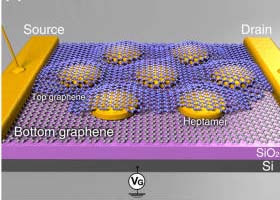Time:2013-03-05ClickTimes:
Dr. Zheyu Fang, and his research collaborator published their work in ACS
Nano about “Plasmon doping of Graphene”. (ACS Nano 2012, 6, 10222) , and
Plasmonic tunability of nanostructured graphene (ACS Nano 2013, doi:
10.1021/nn3055835)
In their experiments, the researchers synthesized a monolayer graphene sheet
on a copper foil and the transferred it to a silicon wafer with a 285 nm thick
oxide layer. They then patterned source and drain electrodes and plasmonic
nonamer antennas onto the graphene using electron beam lithography and gold
evaporation. Under laser irradiation, the hot electrons generated from plasmon
excitation in the gold nonamer antennas are injected into the graphene sheets,
resulting in n-type doping.
A particularly interesting concept derived from these finding of efficient
photo induced doping of graphene is the possibility of generating what the
researchers refer to as optically induced electronics. This work is the follow
up of Dr. Fang’s early work “graphene-antenna plasmonic photodetector” Nano Lett.
2012, 12, 3808.

| 
|
graphene-antenna plasmonic photodetector
(Nano Lett. 2012, 12,
3808)
| Schematic for the optical induced n-p-n graphene transistor
(ACS
Nano,2012, 6, 10222)
|
2)Dr. Fang continues his investigations with Prof. García de Abajo (CSIS) on the
plasmon resonance of nanostructured graphene layer, by doping the graphene with
top gate voltage, they successfully increased the carrier density and Fermi
energy of the graphene monolayer. And Finally observed its dipolar resonance in
the mid-infrared region. As shown in Fig.2, this work was published on line in
ACS Nano ACS doi:10.1021/nn3055835

|
Graphene Plasmon dipolar resonance at mid-infrared region(ACS Nano,2013,
doi:10.1021/nn3055835)
|
3)by collaborating with Prof. Jun Lou,P.M.Ajayan,P. Nordlander,N.J.Halas at RICE
University, Dr. Fang investigated the catalysts effects for hydrogen evolution
with the exfoliated graphitic carbon nitride nanosheets under the visible light,
related paper was published on line in Advanced Materials recently. [Adv. Mater.
2013, doi: 10.1002/adma.201204453]。

|
Graphitic carbon nitride nanosheets as the photocatalysts for
hygrogen
evolution(Adv. Mater. 2013, doi: 10.1002/adma.201204453)
|
All of the above works are supported by State Key Lab for Mesoscopic Physics,
and school of physics, Peking University.
